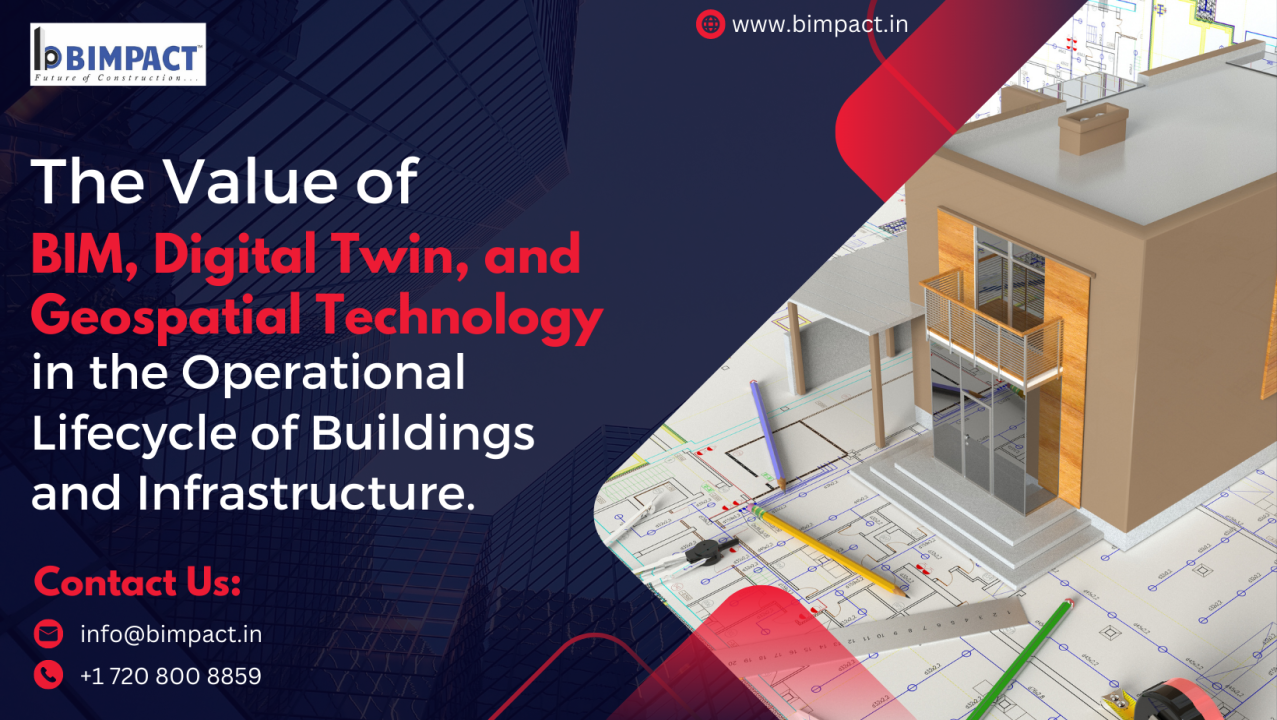
The Value of BIM, Digital Twin, and Geospatial Technology in the Operational Lifecycle of Buildings and Infrastructure
BIMPACT Designs Pvt Ltd
One-stop solution for BIM Services "Future of Construction"
Introduction
In today's fast-paced world, the construction and management of buildings and infrastructure have become increasingly complex. As technology continues to evolve, the integration of BIM, Digital Twin, and Geospatial Technology has revolutionized the way we design, construct, and operate structures.
This newsletter explores the significant value these technologies bring to the operational lifecycle of buildings and infrastructure.
Understanding BIM
What is BIM?
BIM is a collaborative process that enables architects, engineers, and construction professionals to digitally create and manage building information throughout its entire lifecycle. BIM acts as a centralized repository of data, encompassing every aspect of a project, from design and construction to operation and maintenance.
The Components of BIM
BIM comprises various dimensions, including 3D visualization, 4D scheduling (time-related data), 5D cost estimation (cost-related data), and even 6D (sustainability-related data) and 7D (facility management-related data). This multi-dimensional approach allows stakeholders to make informed decisions at each stage of the project.
Advantages of BIM Implementation
The adoption of BIM brings numerous benefits to the construction industry. Improved collaboration, clash detection, reduced errors, and enhanced project visualization are some advantages. Additionally, BIM aids in cost estimation accuracy, leading to better financial planning.
Unraveling the Concept of Digital Twin
A Digital Twin is a virtual representation of a physical asset or system. It captures real-time data from sensors, devices, and other sources to mirror the asset's behavior, performance, and condition. This virtual replica enables analysis, simulation, and prediction to optimize operations.
Digital Twin technology offers real-time monitoring, remote operation, and predictive maintenance. It allows users to assess the asset's health, predict potential issues, and strategize maintenance activities effectively.
By providing comprehensive insights and actionable data, Digital Twin technology empowers stakeholders to make informed decisions, minimize downtime, and maximize productivity. It also supports data-driven improvements in operational efficiency.
The Power of Geospatial Technology
Geospatial Technology involves capturing, analyzing, and visualizing geographic data. It encompasses Geographic Information Systems (GIS), Global Positioning Systems (GPS), and Remote Sensing. Geospatial data plays a crucial role in location-based analysis.
By integrating Geospatial data with BIM and Digital Twin, organizations gain a spatial context that enhances their understanding of assets and environments. This integration creates a comprehensive view of the physical and virtual aspects of infrastructure.
Geospatial Technology offers real-time tracking, monitoring, and analysis. It facilitates efficient asset management, disaster response, and urban planning. Additionally, it helps optimize logistics, transportation, and resource allocation.
The Convergence of BIM, Digital Twin, and Geospatial Technology
The integration of BIM, Digital Twin, and Geospatial Technology results in a powerful collaboration that unlocks new possibilities in the construction and management of buildings and infrastructure. These technologies complement each other, providing a holistic approach to decision-making.
领英推荐
The combined approach enhances project visibility, streamlines workflows, and fosters more effective communication between stakeholders. It facilitates seamless data exchange, enabling better planning, construction, and maintenance.
The Impact on Building and Infrastructure Operations
The integration of BIM, Digital Twin, and Geospatial Technology streamlines facility management processes. Facility managers can access real-time data to make data-driven decisions, optimize space utilization, and enhance occupant experience.
Predictive maintenance powered by Digital Twin technology and Geospatial data enables early detection of issues, reducing downtime, and extending asset lifecycles. This proactive approach enhances overall asset performance and reduces maintenance costs.
By analyzing real-time data from sensors and Geospatial sources, building operators can identify opportunities for energy conservation. The optimization of energy usage contributes to sustainability goals and cost savings.
Challenges and Limitations
With the vast amount of data being collected and shared, ensuring data security and privacy is paramount. Robust security measures must be in place to safeguard sensitive information from potential cyber threats.
Integration between BIM, Digital Twin, and Geospatial Technology may encounter interoperability issues. Standardization and open data formats are essential to ensure seamless data exchange and collaboration.
The initial investment in implementing these technologies and providing training for staff can be substantial. Organizations need to carefully assess the long-term benefits and potential return on investment.
The Future of BIM, Digital Twin, and Geospatial Technology
The future holds exciting advancements in BIM, Digital Twin, and Geospatial Technology. Enhanced AI capabilities, increased automation, and improved data analytics will further elevate the potential of these technologies.
The benefits of BIM, Digital Twin, and Geospatial Technology extend beyond construction and infrastructure. Industries like healthcare, transportation, and agriculture can leverage these technologies to drive innovation and efficiency.
The integration of BIM, Digital Twin, and Geospatial Technology lays the groundwork for smart city initiatives. These technologies will play a pivotal role in creating sustainable, efficient, and connected urban environments.
Conclusion
In conclusion, the value of BIM, Digital Twin, and Geospatial Technology in the operational lifecycle of buildings and infrastructure cannot be overstated. From optimizing construction processes to enhancing facility management and enabling predictive maintenance, these technologies are revolutionizing the way we design, build, and manage our built environment.
For more information …Contact BIMPACT?Designs Pvt. Ltd. at +91 80035 33335, +1 720 800 8859 or?[email protected].
Our Company Website